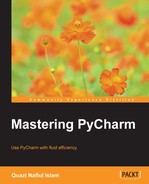Book Description
Use PyCharm with fluid efficiency to write idiomatic python code
About This Book
- Understand how PyCharm works and how you can leverage its strength to develop applications quickly
- Master PyCharm's editor to get a fast workflow
- Full of examples and illustrations that focus on the practical aspects of using PyCharm
Who This Book Is For
If you know PyCharm but want to understand it better and leverage its more powerful but less obvious tool set, this is the book for you. Serving as a launch pad for those who want to master PyCharm and completely harness its best features, it would be helpful if you were familiar with some of Python's most prominent tools such as virtualenv and Python's popular docstring formats such as reStructuredText and EpyType.
What You Will Learn
- Understand the internal workings of the IntelliJ Platform
- Leverage PyCharm's powerful search tools, and learn which ones are the best for you and your workflow
- Customize PyCharm's enhanced Python interpreter and its inbuilt terminal
- Develop web applications quickly and easily with different frameworks such as Flask and Django
- Understand how code completion works in PyCharm for Python and JavaScript
In Detail
PyCharm is addictive, with powerful and configurable code completion, superb editing tools, top-notch support, diverse plugins, and a vibrant ecosystem to boot. Learning how PyCharm works and maximising the synergy of its powerful tools will help you to rapidly develop applications.
From leveraging the power of the editor to understanding PyCharm's internals, this book will give you a comprehensive view of PyCharm and allow you to make your own choices about which workflow and tools are best for you.
You will start by getting comfortable with PyCharm and making it look exactly like you want. You can customize the tools and taskbars to suit individual developers' coding styles. You also learn how to assign keyboard shortcuts. You will master debugging by inserting breakpoints, collecting runtime data, and debugging from the console. You will understand how PyCharm works underneath and how plugins such as Codemap, Vim, Bitbucket, Assets compressor, markdown, bash file, shortcut translator, and .gitignore leverage the power of the IntelliJ platform.
You will become comfortable using the VCS interface in PyCharm and see the benefits of using it for some simple tasks as well as some more complex tasks such as partial commits using changelists.
You will take an in-depth look at the various tools in PyCharm, improving your workflow drastically. Finally, you will deploy powerful PyCharm tools for Django, Flask, GAE, and Pyramid Development, becoming well acquainted with PyCharm's toolset for web development with popular platforms.
Packed with insider tricks, this book will help you boost productivity with PyCharm.
Style and approach
An easy-to-follow guide with plenty of examples and screenshots. Each topic starts off with the goal of enhancing or changing a part of PyCharm to make it suit your needs.
